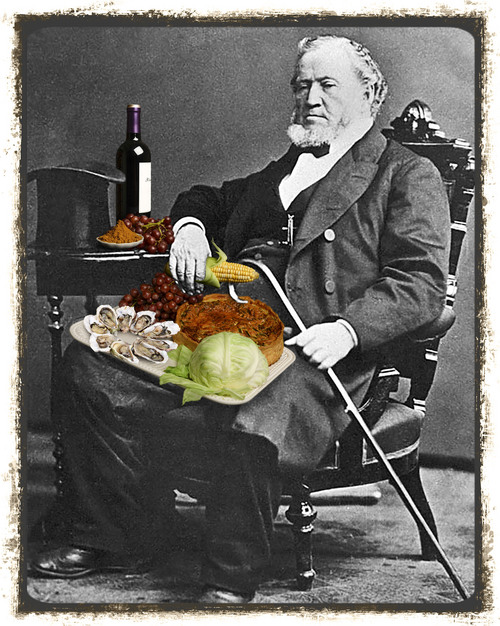This is an archived article that was published on sltrib.com in 2014, and information in the article may be outdated. It is provided only for personal research purposes and may not be reprinted.
As Pioneer Day approaches, Utah tends to remember only those Mormon settlers who survived on boiled mush, sour weeds or — in some cases — nothing at all as they crossed the Western plains.
Of course, the stories about starvation are the exception, said Utah author and food historian Brock Cheney.
Because of their tragic nature, "a lot of our stories about the pioneers talk about the hardships," said the author of "Plain but Wholesome: Foodways of the Mormon Pioneers."
"But once they were settled, the pioneers had everything they needed," said Cheney, who lives in Willard and teaches middle school.
His book, published by University of Utah Press, includes 100 pioneer-era recipes and uses diaries, newspaper accounts and other historical documents to track what the pioneers ate and drank.
While everything from milk and molasses to tea and trout was available for everyday consumption, Utah residents might be surprised at some of the other foods the early pioneers enjoyed.
Here are seven surprising pioneer staples.
Quiche, please! • The Danish-born pioneers living in Southern Utah around the 1860s made zwiebelkuchen, a cobbler with eggs, milk, sliced onion and biscuit dough, "When I first read that, I thought, 'Quiche in the desert? Isn't that fancy?' " said Cheney. "It's not the gruel you would think they ate." In "Plain But Wholesome," Cheney quotes from the diary of Rosina Beacham, whose family made the dish. "We would mix a batter out of flour and cream and put some salt and chopped onion in it and an egg. We would put this on the paddle and slip it off into the oven. It made a very good cake."
Oysters on the half shell • By the late 1800s, thanks to the arrival of the railroad, Utah grocers had begun offering "oysters in tins," said Cheney. The availability of that delicacy led to a suggestion by The Deseret News that someone should introduce live oysters into the Great Salt Lake. Historical records show that at least one box of fresh oysters was shipped by rail and stage from the East. The oysters were covered with ice and at every stop railroad agents would sprinkle cornmeal into the crate. As the ice melted, the meal would filter down to the oysters, feeding them and keeping them alive on the long trip west. Of course, "that was definitely not typical," said Cheney.
Wine stores • In the fall of 1860, LDS Church President Brigham Young sent families to Southern Utah to grow cash crops including cotton, sugar, tobacco, figs and grapes. The latter would be used to make wine for the sacrament, as medicine and for trade. "The grapes really took off and they grew thousands of bushels a year," said Cheney. "It was pretty much their main crop." At that time, Cheney said, Mormons paid tithing in products and commodities, such as a bushel of wheat or a pound of butter. With so much wine being made, the Mormons living in Dixie "sent thousand of gallons of wine to Salt Lake City" and the tithing houses quickly developed surpluses, he said.
Sego lily dinner • Before it was Utah's official state flower — and protected by law — the sego lily grew prolifically across Utah valleys and was a dinner staple, Cheney said. The Shoshone Indians who lived in the valley taught the pioneers how to forage and cook the flower's bulb. In his book, Cheney quotes from the diary of Lorena Washburn Larsen, a Mormon girl living in Manti around 1868. "In my childhood our whole group of children used to go east of town, each carrying a sego digger. It was a piece of wood sharpened on one end and flat on the other. We would just go out of town and look for segos, which were plentiful."
German sauerkraut • Shortly after settling the little town of Providence on the south end of Cache Valley, Swiss and German pioneers began a local harvest dinner, similar to the Oktoberfest celebrations of their homeland. The meal included sauerkraut and other traditional foods. The Providence Sauerkraut Dinner continues to be an annual event some 150 years later. Today, residents are tending to 1,200 cabbage plants for the Oct. 11 event.
Hominy, hominy, hominy • While it is associated with the Old South, hominy "ran through all levels of Mormon cuisine," Cheney wrote. At least one Mormon soldier survived on a diet of hominy and beef while awaiting the arrival of U.S. troops in Echo Canyon during the Utah War of 1857. And the menu for the high-class Territorial Ball of 1860 "featured hominy as part of the vegetable course."
Exotic curry • Major Matthew McCune, a doctor with the British Royal Army, was stationed in India before he and his wife, Sarah Elizabeth, were forced to leave because of political instability. Instead of returning to England, the Mormon converts followed the migration to Utah, bringing curry and other exotic spices to their new home in the West. Cheney said Sarah McCune used curry to spice special dishes served at teas and luncheons with her friends "and maybe even a July 24 social."
Plain But Wholesome
Brock Cheney's book about the foodways of the Mormon pioneers costs $19.95 and is published by University of Utah Press. He blogs at pioneerfoodie.blogspot.com/



